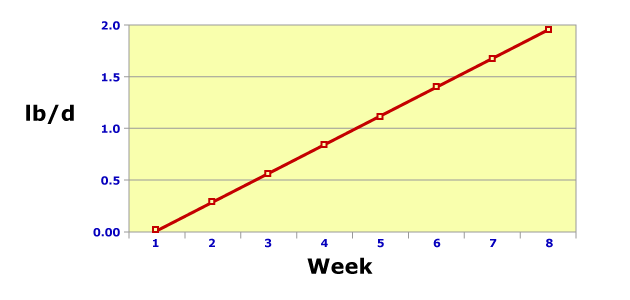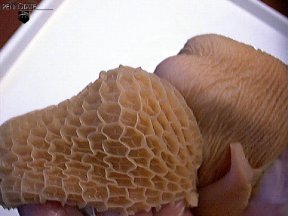Previous Page | Right click this page to print.
Pre-Weaned Calf: Dry Feed, Cold Stress, Forage
We also will introduce a dry feed or starter within the first week of life. This is always high quality, to encourage consumption and therefore early weaning. By early weaning, we are targeting about eight weeks. So why wean early? The earlier we can wean, the quicker we can these calves off of liquid feed which is running about a dollar per head per day. And also after weaning, we can get these animals into a group-house situation and they require less labor. There are a few characteristics of a high quality starter or dry feed, these are dependant upon the ingredients, the minimum of dustiness and feeds that are palatable. Why offer starters to calves? This graph depicts the gain of calves that are only fed milk for the first two months of life.

Initially, up to about two weeks of age, the animals are gaining relatively good at about a pound per head per day. But after this, more and more of the milk is going for maintenance requirements because the animals are gaining weight and less and less is going toward gain. Actually, if you feed a Holstein calf a gallon of milk per day, by about two months of age this animal will not be gaining any weight. The entire gallon of milk or the nutrients in the milk will be going toward maintaining body weight. Currently, in the industry, what we feed is about an 18% starter.
Nutrient |
DM basis |
|---|---|
Crude Protein
| 18% |
Fiber |
12% |
TDN |
82% |
Ca |
0.7% |
P |
0.4% |
Vit A |
2000 IU/lb |
Vit D |
300 IU/lb |
Some of the new programs are recommending starters 22% to 24%. We do provide a bit of fiber in this. It is generally very high in TDN, about 82%. Some ingredients that we look for in starters are coarse bulky ingredients, ingredients that minimize dust and usually we are looking for a bit of a roughage source. Some very good ingredients that we can add in starters are crimped oats, rolled barley and rolled corn. Coarse and bulky are very important to the calf. They consume cracked, crimped or rolled grains much better than they do finely ground grains. Most of the time, you will also find molasses in these starters, this improves palatability. Many starters are also medicated. They will contain antibiotics and coccidiostats. And as far as a feeding regimen, we would like to start providing starter by or during the first week of life. We want to keep it fresh. Feed the animals ad-lib or as much as they will consume. And water should also be available the first day of life, because animals do not get enough water from liquid feeds alone. This is the starter intake for most calves.

Even though we are going to provide it the first week of life, calves will actually eat very little. Most calves will not eat any starter during the first week of life. But we want to provide it to get them acclimated or accustomed to a dry feed. By the third week of life, calves are eating about a half a pound of starter per day. By the fifth week, slightly more than a pound. And by weaning or the eighth week, calves should be consuming somewhere around two pounds of starter per head per day.
What about cold stress or feeding extra milk in areas of the U.S. where cold stress may be a problem. This table depicts temperature, in Fahrenheit,, ranging from 68 to 14.
Temp |
Birth
to 3 wk |
>3
wk |
|||
|---|---|---|---|---|---|
°F |
°C |
NEM |
Milk, lb |
NEM |
Milk, lb |
68 |
20 |
0 |
0 |
||
59 |
15 |
13 |
0.70 |
||
50 |
10 |
27 |
1.41 |
||
41 |
5 |
40 |
2.11 |
13 |
0.85 |
32 |
0 |
54 |
2.82 |
27 |
1.70 |
23 |
-5 |
67 |
3.52 |
40 |
2.54 |
14 |
-10 |
81 |
4.23 |
54 |
3.39 |
Then we have a couple of columns each for young animals those less than three weeks of age, and animals greater than three weeks of age. At about 68 degrees Fahrenheit, this is the lower critical temp for calves less than three weeks of age. Below this temperature, calves will actually start expending energy to maintain body temperature which otherwise could go to weight gain. If we look at freezing or somewhere around freezing, 41 to 32 degrees Fahrenheit, we can see that the energy requirement or the net energy for maintenance of these animals has increased by about 40 to 50 percent. So that means about half the milk they were consuming, is now going to maintaining body temperature rather than weight gain. What we would need to do is supplement these animals with about another quart per day. You can see that at very cold temperatures, we actually need to feed an extra bottle a day, so go to three feedings per day. At 14 degrees Fahrenheit, these young calves need an extra 4.2 pounds of milk per day or an extra two quarts. Now older animals, calves greater than three weeks of age, have a lower critical temperature. Actually, it is somewhere between 40-50 degrees or below this they start expending energy to maintain body weight.
What about forage for pre-weaned calves? So are calves more like ruminants or monogastrics for the first two to three weeks of life? Actually, they are more like monogastrics. The size of the abomasum is greater than the rumen, the reticulum or the omasum. Even though, eventually, these calves are going to develop into ruminants is it necessary to feed these calves hay prior to weaning? In general, they waste most of it. What research from Penn State has shown that actually forage hampers rumen development. The rumen wall uses butyric acid as an energy source and for development. And the calf gets very little butyric acid from hay diets. Actually, the majority of the butyric acid is produced from grain or high starch diets. What happens if you feed calves hay? Some calves have a preference for hay versus starter, so those calves consume hay and it limits rumen development. This picture shows the rumen and the reticulum, which has the honeycomb appearance, of calves that were fed milk only.

The second picture depicts the rumen and the reticulum of calves that were fed milk plus starter during the first eight weeks of life.

Now if we compare these two pictures, picture two is what we want the
rumen and the reticulum to look like. The major difference is that we
will notice that the papillae in the rumen or the segment of the gut that
is on the left (lower), is much more developed than the calves that were
fed grain. You will also notice a difference in color. This color is mainly
due to increased blood flow in the reticulum and rumen. These calves that
are fed grain for the first eight weeks of life have better rumen development,
more blood flowing through the rumen.
Previous Page | Right click this page to print.